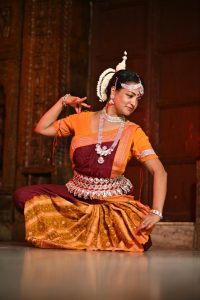Artist Interview: Guru Chhanda Das Saxena
Interview By: Emma Lum

“Factors like limited time, other priorities, non-cooperative health and inexperience with this dance form often challenge us, but they should never end up discouraging us. The more we know ourselves, the less approval we need of others”.
Chhanda Das Saxena
Guru Chhanda Das Saxena, an immigrant from India, is an Odissi dancer based in Scarborough Toronto. At the age of 5, Chhanda began training for 17 years in a variety of techniques such as balance, ancient hand postures known as mudras, rhythmic steps, eye movement, expression, sacred geometry, breathing, meditation, and energetic control.In anticipation for her performance for the Inclusive Arts Festival, we spoke with Chhanda about the importance of dance and culture in our current context.
AADN:
Chhanda, I am curious to know, what inspired you to begin dancing, and what is it about Odissi dance that stood out to you?
Guru Chhanda Das Saxena:
I learnt Odissi whenI was 5. After a break of 13 years, I began relearning and subsequently teaching when I was pregnant with my second one. It was a unique yet challenging experience getting back to the endurance of this dance form after a gap but my belief that the physical and interpersonal nature of Odissi has the unique ability to transform people’s understanding of the world around them and keep the roots of our culture alive amongst our youth is what inspired me everyday. I get happiness from “what” I do; and fulfillment from “why” I do it.
AADN:
What is it about Odissi dance that makes you feel passionate?
Guru Chhanda Das Saxena:
Odissi originated more than 2000 years ago in the temples of Odisha, an Indian state and is considered the oldest of the 5 Indian classical dance forms. The theoretical foundations of this dance trace its roots to the ancient Natya Shastra. The dance has Spirituality in its core and a body-mind-consciousness well entrenched in time tested systems of yoga – its poses pay attention to energy pathways that flow through the body, and its hand gestures have startling resemblance to those in yoga. That’s what makes me fall in love with this dance form. EVERYDAY.
AADN:
And could you give an example of the types of training you have developed for those 17 years?
Guru Chhanda Das Saxena:
It has been full circle for me. Through this dance form, over the last 17 years, I have explored balance, ancient hand postures known as mudras, rhythmic steps, eye movements, expressions, sacred geometry, breath, meditation, energetic control, emotion, and storytelling of mystical gods, goddesses, humanity, and nature. When I began learning this dance form at 5 years of age, I could hardly pronounce the names of the mudras (hand movements) or pada bhedas (feet movement), so now as a teacher, I try to make dance more relatable to little minds during each class and as a result, experiment with my productions consistently. The relatability increases learning retention.
AADN:
Chhanda, I understand you also have a dance academy as well called Odissi Academy. I am interested about how your background as an Indian influences your dance and how you teach your students at the academy?
Guru Chhanda Das Saxena:
This is a difficult question to answer and honestly, Odissi is now so global in reach and influence that I don’t think the response would vary if it was for a person with any other nationality. But yes, coming from an Indian household, mindfulness and other aspects of meditative techniques that we have practiced as part of our societal nurturing, has truly bought Odissi’s multidisciplinary approach to life for me. In class, I challenge my adult students (who are often in their late 30s all the way to their late 50’s) to harness the same progressive attitude that breaks caricatured barriers associated with their own introvertedness, denial and cynicism. These women in turn inspire little kids, tweens and teens to associate with drama, history, poetry, color and music through dance.
AADN:
Inclusivity and accessibility is exemplified throughout your dance academy. Illustrate why this is so important in our current social context.
Guru Chhanda Das Saxena:
I always tell my students that there is simply no reason, nor time, to perpetuate clichés that societal barriers lay on us. Factors like limited time, other priorities, non-cooperative health and inexperience with this dance form often challenge us, but they should never end up discouraging us. The more we know ourselves, the less approval we need of others. My dance academy challenges tyrannical body standards to dance, and the white-washed world of performance. We truly believe that race, religion or ethnicity is no barrier to dancing and that diversity and inclusion are the basic tenets to classical dance. As they rightly say – Diversity is being invited to a party; inclusiveness is being invited to dance!!
AADN:
What performances have you prepared for the Inclusive Arts Festival?
Guru Chhanda Das Saxena:
We will showcase two performances for the Inclusive Arts Festival ‘22. The kids group will perform on the classical instrumental version of Girls like you and leave the audience with a deep societal message about Girls Empowerment through Diversity. The adults group will create magic with a classical rendition of “Mi Gente”. Mi Gente means my people – we chose this particular track in an attempt to depict the theme of inclusion within the mosaic of varied cultures in the world.
AADN:
Lastly, will you have any future projects, performances or showcases?
Guru Chhanda Das Saxena:
Some of our notable past event representations included the Canadian Indian Association Republic Day ‘20 and ‘21, inclusive Arts Festival ‘20 and ‘21, HGSS Canada Day, panorama India Republic Day and Independence Day ‘22, Milton Culture Days ‘20 and ‘21, South Asian Heritage Month celebrations ‘22, and the International Gita Mahotsav ‘22.
The last two years have been extremely busy for us and we have enjoyed every bit of it – Stay tuned for many more future showcases!
Editor: Ezel Urul
